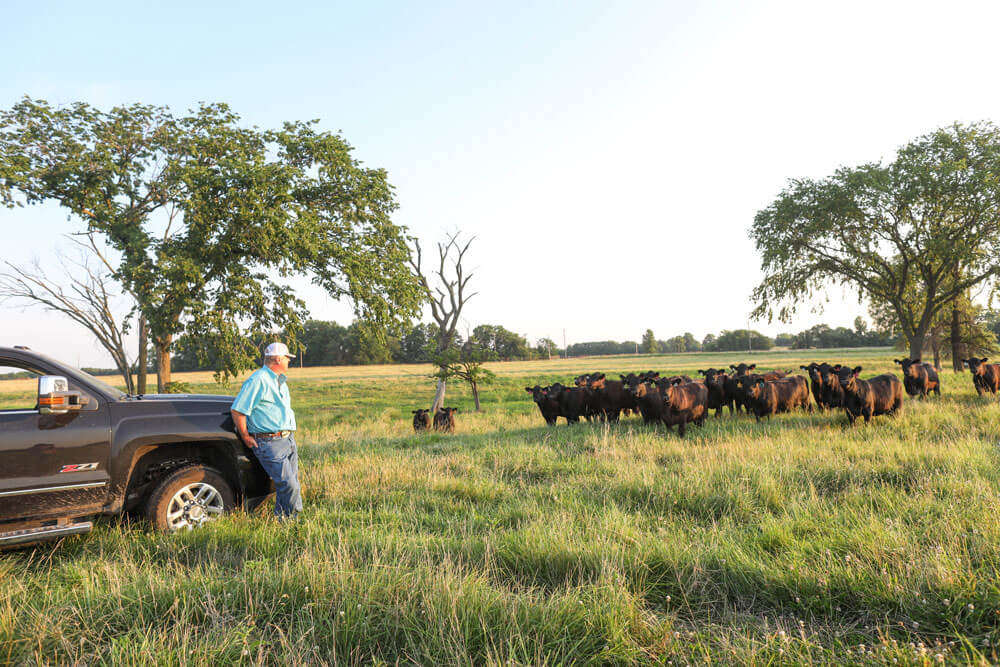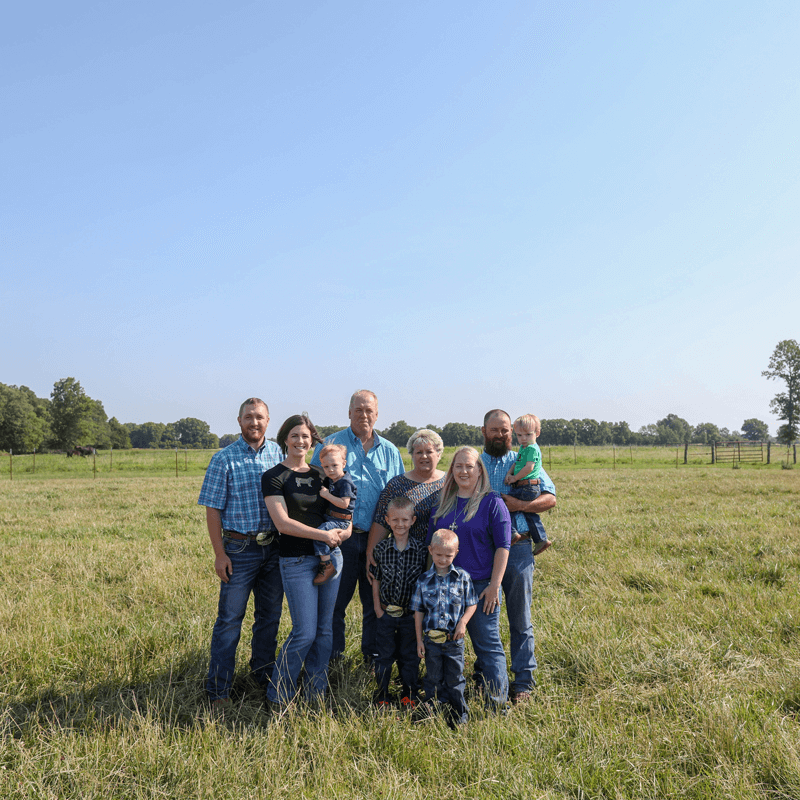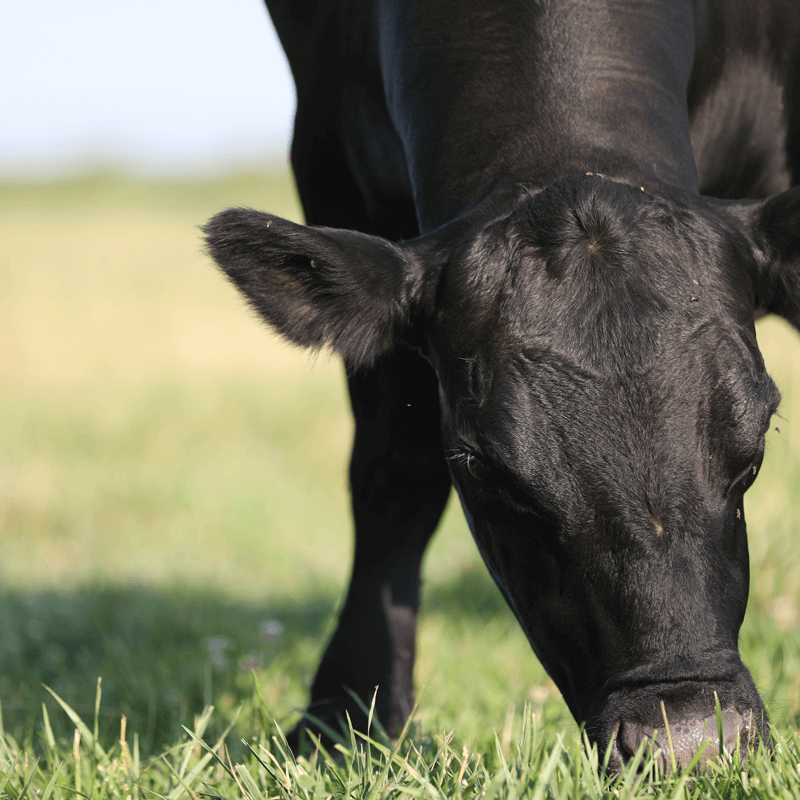Building Better Beef
There was no big vision, just a passion for Angus cattle. Limited in land, time and resources, Hinkle always knew he’d never be big, but resolved that his few would be some of the best. It wasn’t about making a name or even making a dollar, it was just something he wanted to do.
What most didn’t realize is that under his baseball cap, Hinkle is a modern-day beef maverick.
It began by just selling a few bulls to folks down the road. The pennies earned were reinvested into the business, helping him get better each year, adding more value with each new mating.
His first bull sale was held in a tent. Over the years, the seeds Hinkle planted grew to a flourishing business that markets 300 Angus bulls annually — the now-veteran cattleman develops them all on or next to his original 30 acres.
Today, when visitors ask to be shown the “ranch” and want to see the big cow herd, Hinkle gives a vague gesture of his arm at the pasture across the road and says, “We’re here.”
His blue eyes sparkle as he jokes that he got his start in the beef business because he was “stupid and didn’t know any better.” But each decision he makes is calculated. Hinkle moves with purposeful precision, making the most of the limited resources with which he is still challenged. His bulls are entirely the product of artificial insemination (AI) and embryo transfer (ET). The massive registered cow herd doesn’t exist.
“It’s hard to find a registered female here over four years of age that’s not a recip,” Hinkle says. “We don’t have a big cow herd because we don’t have anywhere to put them.”

He’s still focused on making the best from what he has in front of him. The cow herd and bulls are developed on about 500 acres of forage and through the help of a few local cooperating herds.
“If we can produce 200 calves a year out of 12 elite cows, we’re putting a very good product out there,” Hinkle says.
He isn’t just producing a good product; he’s focused on breeding the very best. This mindset and years of diligent focus on that goal earned him the 2018 Certified Angus Beef (CAB) Progressive Partner Award.
Flip through the pages of the Hinkle’s Prime Cut Angus (HPCA) sale catalog and you’ll find more than expected progeny differences (EPDs) and genomic profiles. There’s a carcass data record, showing his bull customers’ past feedlot and rail performance. It’s a story of how Hinkle genetics add value to the person next in line.
“It’s important to us, because it’s important to our commercial customers,” he says. “Some years the only way these guys make money is by feeding these cattle and it’s because these cattle feed well.”
For the HPCA crew, the status quo isn’t an acceptable option – for them or their customers.
“Anyone can make a hamburger and I think that’s the mindset we take,” says his son, Trevor. “Hamburger is hamburger. Where people are really going to make the money is Choice and Prime cuts and figuring out how to make those more and consistently better.”
The father-and-son team work in tandem with Hinkle’s son-in-law, Blake Baker. The Angus dream began with the family patriarch but it’s a life the entire family works in today.
And it’s the data that drives them forward.
“Carcass merit and quality is a motivating factor because our customers can get paid more for it,” says Baker. “Average cattle is low, for what a lot of these guys can do. Seeing them get $200 more per head in premiums is something we’re proud of and it helps take some of the risk out of it for them.”

Jeremy Zoglmann is one such customer. The commercial cowman who raises his Angus herd on the other side of town from Hinkle’s sets his sights on calves that qualify 60% or more for CAB, with a goal of 20% Prime. He began retaining ownership in 2013 after a nudge from Hinkle, and his first cutout sheet came back 100% Choice or better. Since then, he’s travelled as part of organized HPCA customer tours to Hy-Plains Feeders at Montezuma, Kan., and built relationships that help him continue to meet his goals. In recent loads fed there, Zoglmann hit his target and earned as much as $280 in premiums per head above what he’d get paid marketing them live.
It’s a story many of Hinkle’s customers could tell.
“Kenny understands the value of his cattle and how to treat people well,” Baker says. “He’s got great genetics, but the reason a lot of people come back has a lot to do with how he treats them, teaches them and stands behind them.”
For Hinkle, those stories and numbers signal victory.
“I know I’ve hit my mark when I see my customers’ kill data,” he says. “I’ve got the genomics, the ultrasound numbers, but nothing shows success like that individual performance data.”
-
“I think paying attention to carcass traits is the future of the breed and the future of us,” says Trevor Hinkle. “We’re pushing our genetics and I think you have to do that with the best cows and the best bulls.”
Science and the resulting statistics have always been Hinkle’s guide. A student of numbers, he gathers information on everything from a cow’s mothering ability in the first 30-60 days to a bull’s feed-conversion performance and how the progeny of his genetics execute in the feedlot phase.
Although that data eventually goes into the production of bulls, he says it’s a focus on the female that has helped evolve from that small, unproven herd 25 years ago to a top-tier genetic supplier today. Hinkle balances traits for optimum performance and says, since the cow makes up half of the desired outcome, she deserves attention.
He points to a six-year-old cow grazing in his donor pen: “People can argue with me all day, but when you look at the numbers, she’s good,” he says. “Not one bull out of her has thrown a calf that’s gone Select.”
Chasing extremes isn’t his game, and his focus on carcass isn’t offset by a lack of performance.
“We want as much as you can have in an acceptable package, but when it comes to marbling, I don’t see a limit,” he says. “We don’t want as much as we can get in all of them – not every bull can be a 1.8 IMF (intramuscular fat), but I never don’t use a bull because he has too high marbling.”
As for the female, Hinkle doesn’t buy the theory of a hard-doing, high-marbling cow. Cautious but focused, his females fall on the higher end of the $B value index spectrum; most are far above breed average for marbling, but if his replacement females don’t portray strong mothering abilities as first-calf heifers, they don’t make it to the donor pen.
“Anyone can buy strong semen on any bull that’s for sale,” he says. “But to have a high-quality female to match – that’s where it’s at.”



Words like “maternal” and “terminal” aren’t what Hinkle will use to describe his program. It’s a collective mission to produce a calf that comes easy and grows rapidly with the genetic capacity to excel in performance and profitability at every point in the beef supply chain.
“Some people call them carcass cattle, I just call them good cattle,” he says. “Don’t tell me we can’t raise cattle in this breed that do everything and still have marbling.”
As he looks to the horizon, it’s not his own success that weighs on Hinkle’s mind. “At the end of the day, I just hope we are helping people survive in the beef business.”
It doesn’t matter if that’s his own kin, the customer down the road or the consumer eating his beef in a steak house in New York, he’s focused on adding value to each as they take their turn in developing or enjoying the genetic foundation that starts at his place.
“The Certified Angus Beef brand is why we’re here,” he says. Janyce finishes his thought, “We want the best steak on that table and that’s what we hope we can do with CAB.”
For now, that focus is continuing to make some of the best beef even better.
“Can you imagine what would happen to beef demand if every animal we raised on this earth, or even just in the United States went upper two-thirds Choice and Prime?” Hinkle asks. “There would be people gobbling it up.”
To some, it might sound crazy. To a man who built a business with nothing but two hands and a dream, it’s simply another task on his to-do list.
You Also Might Like…
$100,000 Up for Grabs with 2024 Colvin Scholarships
Certified Angus Beef is offering $100,000 in scholarships for agricultural college students through the 2024 Colvin Scholarship Fund. Aspiring students passionate about agriculture and innovation, who live in the U.S. or Canada, are encouraged to apply before the April 30 deadline. With the Colvin Scholarship Fund honoring Louis M. “Mick” Colvin’s legacy, Certified Angus Beef continues its commitment to cultivating future leaders in the beef industry.
Carcass Quality Set to Climb Seasonally
With the arrival of the new year the beef market will rapidly adjust to changes in consumer buying habits. This will remove demand pressure from ribs and tenderloins, realigning the contribution of these most valuable beef cuts to a smaller percentage of carcass value
Raised with Respect™ Cattle Care Campaign Launched This Fall
Raised with Respect™ was developed as part of a strategic cattle care partnership between Sysco and CAB. The collaboration focuses on supporting farmers and ranchers, equipping them with continuing education to stay current on best management practices and helping to increase consumer confidence in beef production.



